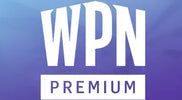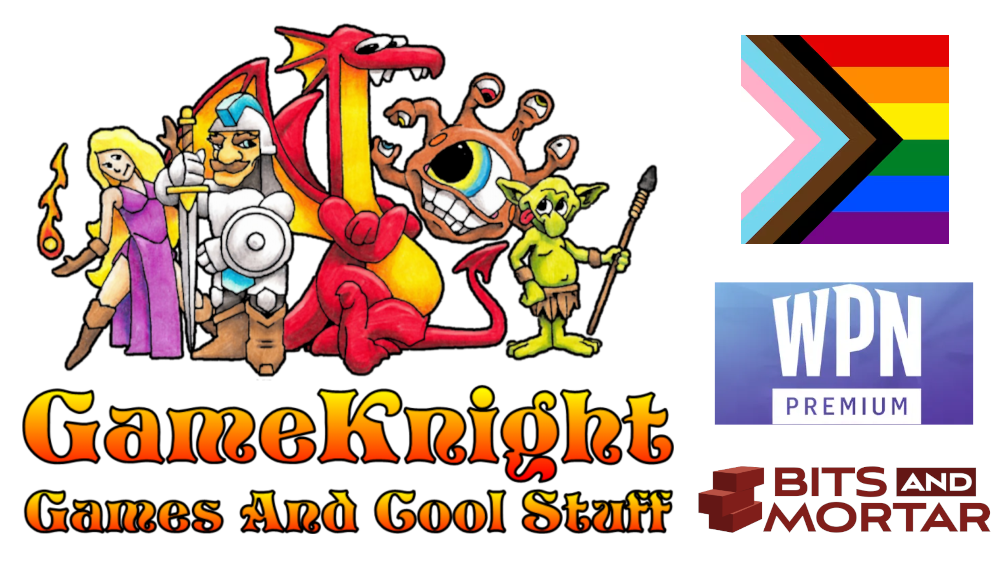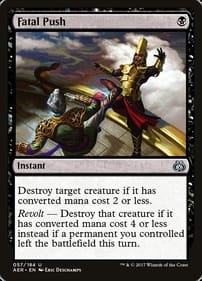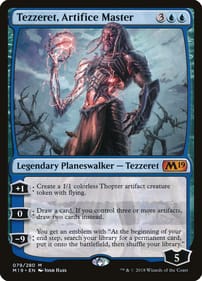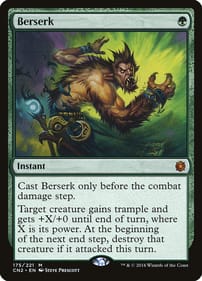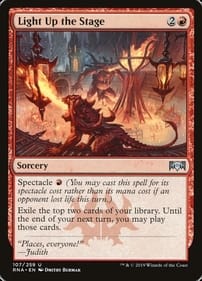In Flesh and Blood, every card that you play represents something that your hero can do, from weapons to different styles of attacks to defensive cards to even items like Potions which provide one time boosts. When you play FaB, you are the hero and the cards represent what your hero does to achieve victory.
The Anatomy of a Card
To understand how to play Flesh and Blood, one must first understand how to read the cards. The amount of text on a card varies, but a lot of them use short hand or symbols to denote common actions a player can take in the game. As the core of FaB's gameplay revolves around heroes of varying classes, we'll first look at Ira, Crimson Haze, a ninja hero from FaB's Welcome Deck:

Card Name - This is the name of the Hero or Action card. In this case, it's Ira, Crimson Haze.
Card Effects - What the card does while in play. This can also include triggered abilities that only occur when you've met some condition during the game. For Ira, she only has a passive ability but it's a very good one: The second time you attack each turn becomes more powerful, by increasing the damage of that attack by 1. There are many effects in the game and its important to pay close attention to what each does if you hope to win.
Card Type - On hero cards, this denotes your class. On everything else, this field will tell you whether an Action card is Generic or tied to a specific class. As a reminder, you can only use cards in your deck that match your hero's class OR that have the word "Generic" in the card type.
Intellect - Only heroes have this, and it's how big your hand size is. At the end of each of your turns, you'll draw up to your intellect in cards. So in Ira's case, you'll draw cards until you have 4 in hand, and then the turn passes to your opponent. Almost all heroes currently have an Intellect of 4, though there are one or two exceptions to that.
Starting Life - This is how much life you start the match with. For Young heroes, it's often 20 Life while their older versions have 40 Life. There are some exceptions to this, but for the most part, it's always 20/40.
Next up is the second most important set of cards in your deck: equipment! These give you powerful defenses and other abilities that you can use throughout the game. Equipment comes in two varieties: Class-specific, which can only be used by heroes of the corresponding class, and Generic, which can be used by anyone! Let's look at the weapon card from Ira's deck, the Edge of Autumn:

Card Name - Just as with Ira, the name of this weapon is at the top: Edge of Autumn.
Card Type - In the same place as before. This shows you which class can use the weapon. In this case, Edge of Autumn is a Ninja only weapon, so you can only put this in a deck with a Ninja as your hero.
Damage - Just as the name says, this lil' yellow spear is a Damage Icon. The number next to it is how much damage the weapon is capable of inflicting. Some effects can even pump this number up, such as Ira's hero ability (assuming you meet the right conditions).
Once per Turn Action - Many pieces of equipment and heroes have an effect like this. This means that once on your turn, you can pay an Action Point (more on this later) and any resources required to cause the effect on the card to happen. In Edge of Autumn's case, you can use your Action Point and pitch a card for 1 resource to attack your opponent, and gain "Go Again" (an important bit of text that basically means "Get another Action Point").
Note about Action Points: At the start of your turn, you get 1 Action Point. You can use this to play a card from your hand or arsenal, or to activate abilities on heroes, weapons, and equipment. Whenever a card says go again, it means that once it resolves, you will receive one more Action Point to use on another card in the same turn! Chaining together multiple cards with go again is how you play as much from your hand as possible each turn.
And last but certainly not least is an action card, Torrent of Tempo, which is the most common card you will see and play with throughout a match of Flesh and Blood.

Card Name - Third verse same as the first. Say hi to Torrent of Tempo.
Card Type - In this instance, the card type is a "Ninja Action" (Remember, "Action" means that it takes an action point to play it), with the subtype "Attack", meaning that playing this card initiates combat. This card can only go into Ninja decks, as its card type implies.
Pitch Value - These lil' dots in the top left corner are how many resources this card "pitches" for. Red cards generate 1 resource, yellow cards generate 2 resource, and blue cards generate 3 resource. When you pitch cards for resources, they will go to the bottom of your deck at the end of your turn instead of to your graveyard, so you never have to worry about "losing" your cards when you pitch them. In Torrent of Tempo's case, it generates 1 resource when pitched.
Cost - The big red circle in the top right is your resource cost to play the card. You need to have enough Resource generated from pitching cards to pay the entire cost to be able to play a card. Fortunately for Torrent of Tempo, you only need 1 resource to be able to play it, so you can pitch any card to play it.
Card Effects - Often, actions will come with additional effects when played. As long as you meet the conditions in the text box, you'll gain the effect! For Torrent of Tempo, you need to hit your opponent with at least one damage from this action. If you do, Torrent of Tempo gains go again which means you can attack again afterwards (more on go again later once we get into the nitty-gritty)
Hits in Flesh and Blood refer to any time an Attack action causes at least one damage to the opponent. So, for example, if Ira attacks with Torrent of Tempo and the opponent Defends for 4, it would count as a hit because the opponent is taking at least 1 damage, thus triggering Torrent of Tempo's effect and giving you go again!
Damage - Same as on equipment, except most Actions tend to be worth more Damage than weapons. Torrent of Tempo has 5 Damage.
Defense - Only Action cards and Equipment have a defense value. This is how much the card Defends for when used to block an attack. Torrent of Tempo only blocks 3 damage.
Note on "Instant" cards - Instants are a special type of action card that can be played any virtually any time, whether it's your turn or your opponent's turn, assuming you have Resources to pay the Cost on the card. They are somewhat rare effects, but can be powerful in the right situations! Keep an eye out for useful Instants out there to powerup your deck!
Now that we have all that squared away, I think we're about ready to jump into our first game! I would highly recommend the Blitz format, as the lower barrier to entry and smaller deck size makes it easier to get into the game. Let's dive a bit into how a Blitz game is played!
Blitz - The High Octane yet Casual Experience
We'll primarily be talking about Blitz when we start looking at how to play, as this is the casual format of the game. We'll talk more at length about the different formats later, but for now, we're going to focus on Blitz and how to play it as it is the most accessible way to play FaB.
What is Blitz? Blitz is advertised as FaB's casual format, designed to be played at the kitchen table or casually at your Local Game Store. Your deck consists of 40 cards, with no more than 2 copies of a unique card, up to 11 pieces of equipment (called your Inventory), and 1 young hero card. When the match starts, you will choose only a handful of equipment to give to your hero from among a Helm, Chest Piece, Arms, Legs, Weapons, and Shields (one per slot). The unused equipment is set aside and not used for the rest of the game.
What's this "young hero" thing I mentioned up above, though? In Flesh and Blood, every hero has a Young and Old version. The Young versions of heroes are used for Blitz, and have a lower health total than their older versions. That's it, that's the only difference. The rest of a hero's card is exactly the same otherwise. For the most part, heroes have 20 Health when playing Blitz games.
So the TL;DR bit about Blitz is that it's a 40 card deck played with Young Heroes, but otherwise, it plays the same as the other formats in the game.
How to Play
Playing Flesh and Blood is easy, but mastering the game and its systems is another matter entirely! While we can't teach you the latter within the scope of this guide, be can certainly help you get your bearings and make sure you're not caught flat-footed by your opponent.
Below you'll find a step by step guide on how to set up and on the turn order of the game.
Setup
Once you and your opponent have picked your heroes, reveal them at the same time. Then, using a random method (such as dice, a coin flip, etc), determine who will go first. You and your opponent pick cards from your Inventory to equip your hero with one of each a Helm, Chest, Arm, and Leg armor as well as either a One-Handed (1H) or Two-Handed (2H) weapon. Put these cards in their respective slots face down before shuffling your deck. Cut each others' decks, then reveal your equipment to your opponent. You'll each draw an opening hand, and the first turn of the game begins!
Sequence of Play
There are three phases to a turn in Flesh and Blood: The Start of Turn Phase, the Action Phase, and the End of Turn Phase. The Start of Turn Phase only matters if you have any cards in play that say "At the start of your turn" or "Until the start of your next turn" effects. If there is nothing of the sort to deal with, the game proceeds straight to the Action Phase.
When the Action Phase begins, whichever player's turn it is will receive 1 Action Point. Action Points are required to play any Action cards, and to activate "Once per Turn Action" abilities on Equipment, Weapons, and Heroes. You may also need to generate Resources to be able to use the card, too. You generate resources by Pitching cards. Let's take a look at our opening hand and use a practical example to show you what I mean.

Cards from Left to Right: Springboard Somersault, Lunging Press, Salt the Wound, and Brutal Assault
Ira, being a ninja, wants to be able to attack at least twice per turn, if possible. The nice thing about her weapon, the Edge of Autumn, is that for a scant 1 resource investment, we can attack with her Weapon which gives us go again, granting us another Action Point. As Action Points are necessary for playing nearly every card, playing effects with go again becomes critical for players to set up a big, explosive turn!
However, to do that, we need to pitch a card to generate Resources to pay for Edge of Autumn's ability as well as Brutal Assault's cost. To pitch a card, you place it face up to the left of your deck, and you gain Resources equal to the Pitch Value in the top left corner of the card.
You don't need to use all the Resources you generate, and sometimes depending on your deck construction, you might have Resources left over after playing all the cards you want to play. Any Resources you don't lose are lost at the end of the turn, so you can't sit on them, either!
We'll pitch a copy of Lunging Press to generate 3 Resources, and use 1 Resource to activate Edge of Autumn to begin combat.

An example of pitching a card. By pitching Lunging Press, we can gain 3 Resources for the turn....

...and we can use 1 of those Resources to activate Edge of Autumn to attack our opponent!
Once you've played an Attack Action card or activated a Weapon, you open up what is called the Combat Chain. This is where players launch attacks and play their defensive actions, and is the meat of the game. There's lots to unpack here, so we'll go step-by-step.
Step 1: The Attack Step - It is here that the active player begins combat as soon as they play any card with the Attack subtype or activate a weapon that has the Attack keyword. By activating Edge of Autumn, we enter the Attack Step and combat begins.
Step 2: The Defend Step - The defending player has an option of using cards from their hand or their worn Equipment to defend against the attack. The defender doesn't need to pay the costs to use the card to defend, as this is a free action. However, defending requires that you discard the card after it's been used to defend. You can also defend with as many or as few cards as you want, but the more you use from your hand to defend, the less you'll have to attack with on your turn as the number of cards in hand decreases and the quicker your graveyard will fill up with cards you can no longer use. In our example, the opponent decides NOT to defend, as Edge of Autumn only does one damage.
Step 3: The Reaction Step - After the defending player has decided whether to Defend or not, the attacking player has the option to play any Attack Reaction cards they may have in hand. Reactions require that you pay the Resource cost, just like any other action, so keep that in mind! Because we pitched Lunging Press, we can't use it as a Reaction this turn.
Step 4: Damage Calculation - Players don't get any chance to take actions here. During this step, add up the Power (the yellow spear symbol) on your Attack, plus any relevant bonuses from your hero or other actions you've played, and subtract the Defense of the cards the defending player uses from the total. If the Power remaining is at least 1 or more, the attack counts as a Hit, and the opponent loses the corresponding amount of Life. In this case, Edge of Autumn will land for 1 point of damage, causing the opponent's life to drop from 20 to 19.
Step 5: Chain Link Resolution - The final step of combat. If you're the attacker, check to see if any cards you've played grant you go again. If they do (and in Edge of Autumn's case, it certainly does!) you get another Action Point and can play another Action card, if you so wish. If you do not attack again (including playing a 'non-attack' action), the Combat Chain is considered closed, and all Action cards played as well as cards used for Defending will go to their respective Discard piles.
By getting another Action Point from Edge of Autumn's go again effect, we're able to attack a second time and trigger Ira's hero ability, which increases her damage. We still have two Resources from pitching Lunging Press to spend as we see fit this turn, so we'll use those resources to play Brutal Assault and begin the second attack for the turn, which will trigger Ira's special ability and increase the power of the attack!

By playing Brutal Assault as our second attack this turn, Ira's ability will trigger and bump the attack's power from 4 to 5!
If you play a second attack, combat returns to the beginning with the Attack Step, and you would go through the motions again until everything has resolved and you have no Action Points left.
Once you have closed the Combat Chain and taken all the Actions you can take this turn, you enter the End of Turn phase. Any action cards still in play (such as those used for Attacking and Defending) go to your graveyard. If you have any Action Points or Resources left, they are also lost at this point.
You then have an option to place a card from your hand face down in your Arsenal, a sort of "hidden zone" where you can play cards from and feeing up a slot in your hand to draw a fresh card instead. Some cards even get bonuses from being played from the Arsenal.
One thing to keep in mind about placing cards in your Arsenal is that you can only play those cards. You cannot use them to pitch for Resources. You cannot use them to Defend during the Defend Step. You can only play them as you normally would with any Action or Reaction card, meaning they must obey all other restrictions those cards would normally have.

Normally, Springboard Somersault only adds 2 to your Defense when used as a Reaction. However, if you play this card from your Arsenal, it's Defensive value goes up to 4!
Our only cards left in hand now are a Springboard Somersault and a Salt the Wound. As Springboard Somersault gets a bonus for being played from the Arsenal, we'll place it face down below our hero card. Once that's done, any cards left in our Pitch zone are placed on the bottom of our deck in any order that we choose. We'll get to use those cards again later, if the game goes on long enough. Finally, we'll draw up to our Intellect to refill our hand and end our turn. Remember, Ira's Intellect is 4, and since we still have one card in our hand, we only draw 3 new cards and end the turn. Your side of the board will look something like this:

Once that's done, your turn ends, and now your opponent will begin their Start of Turn phase, resolve any triggers, and move on to their Action phase. Play continues in a similar fashion, trading blows back and forth, until one player is reduced to 0 life.
Special Note regarding the first turn of the game - Normally, players will only draw cards to refill their hands at the end of their own turns. On the first turn of the entire game, both players will draw up to their Intellect. Afterwards you will only draw cards at the end of your turn.
What's Next?
You should be all set to play a game of Blitz on your own now! If you're still unsure about how to play the game, Legend Story Studios provides a video on their official YouTube channel that briefly goes into how to play the game. I've linked it below for your convenience.
Should you want any further reading or detail related to anything we talked about, Legend Story Studios provides a quick-play guide called the "Hero's Handbook". I highly recommend checking it out as, in addition to the basic rules, it provides advanced rules on more complex mechanics, more detailed card anatomy pictures, as well as a glossary of game terms!
Check out the official Hero's Handbook here!
In our next article, we'll be looking at the first four classes in Flesh and Blood as we dive into the premier set for the game, Welcome to Rathe!
